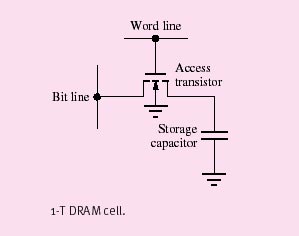
(See related pages)
For many years, high-density memory has served as the IC industry’s vehicle for driving technology to ever smaller dimensions. In the mid-1960s, the first random-access memory (RAM) chip using MOS technology [1] was discussed at the IEEE International Solid-State Circuits Conference (ISSCC) [2], and in 1974 the first commercial 1024-bit (1-Kb) memory was introduced [3]. By 2000, experimental 1-gigabit (Gb) chips had been described at the ISSCC, and the technology for future 1-Gb memories had been discussed at the IEEE International Electron Devices Meeting (IEDM)[4]. Thus, just 30 years after the introduction of the first commercial MOS RAM chips, chips have been demonstrated with more that 1 million times the storage capacity of the original RAMs.
The circuit that made these incredible memory chips possible is called the one-transistor dynamic RAM cell or 1-T DRAM. This elegant circuit, which requires only one transistor and one capacitor to store a single bit of information [1], was invented in 1966 by Robert H. Dennard of the IBM Thomas J. Watson Research Center. In this circuit, patented in 1968, the binary information is temporarily stored as a charge on the capacitor, and the data must be periodically refreshed in order to prevent information loss. In addition, the process of reading the data out of most DRAM circuits destroys the information, and the data must be put back into memory as part of the read operation. At the time of the invention, Dennard and a few of his colleagues were probably the only ones that believed the circuit could be made to actually work. Today, there are arguably more 1-T DRAM bits in the world than any other electronic circuit. |
